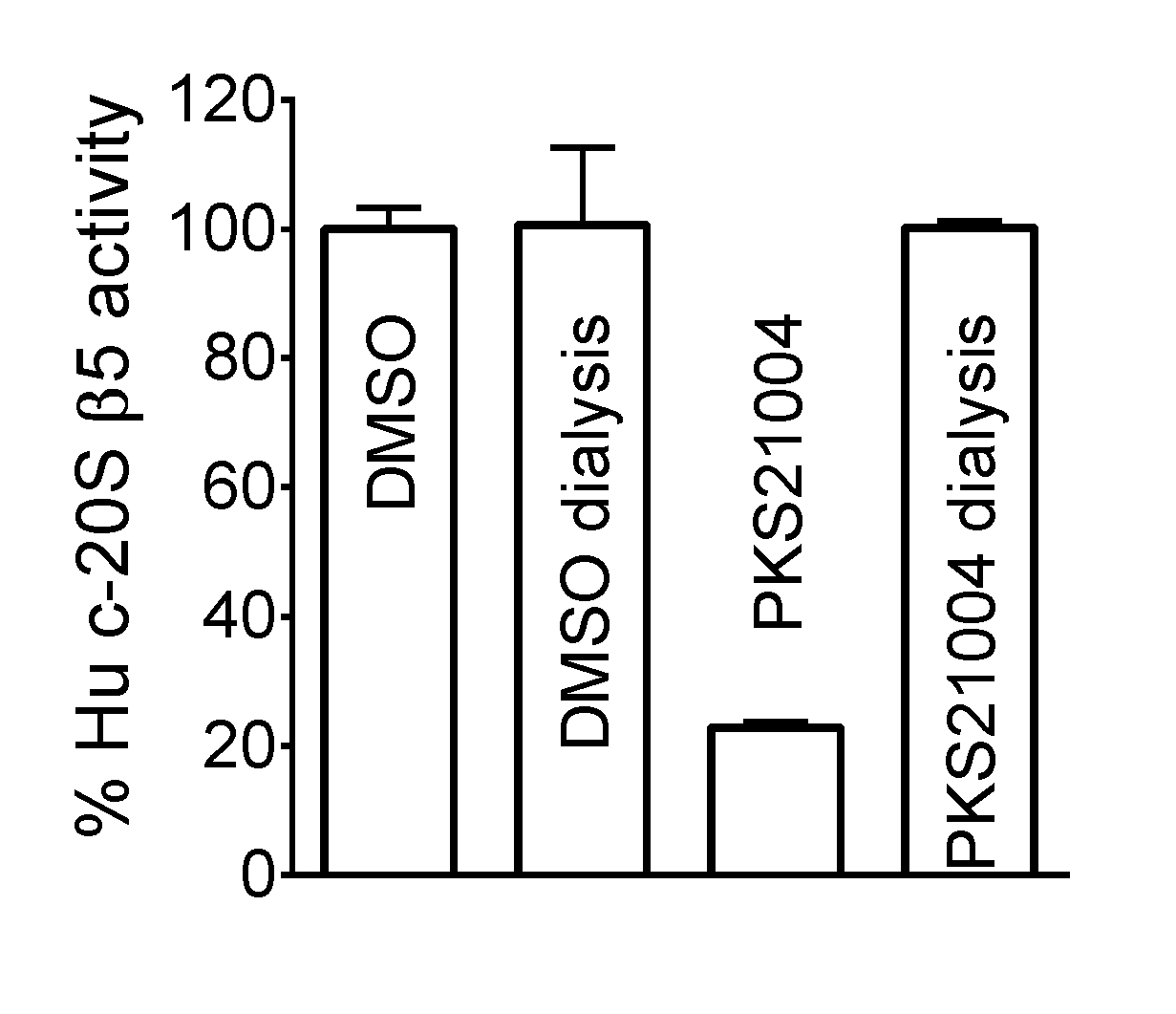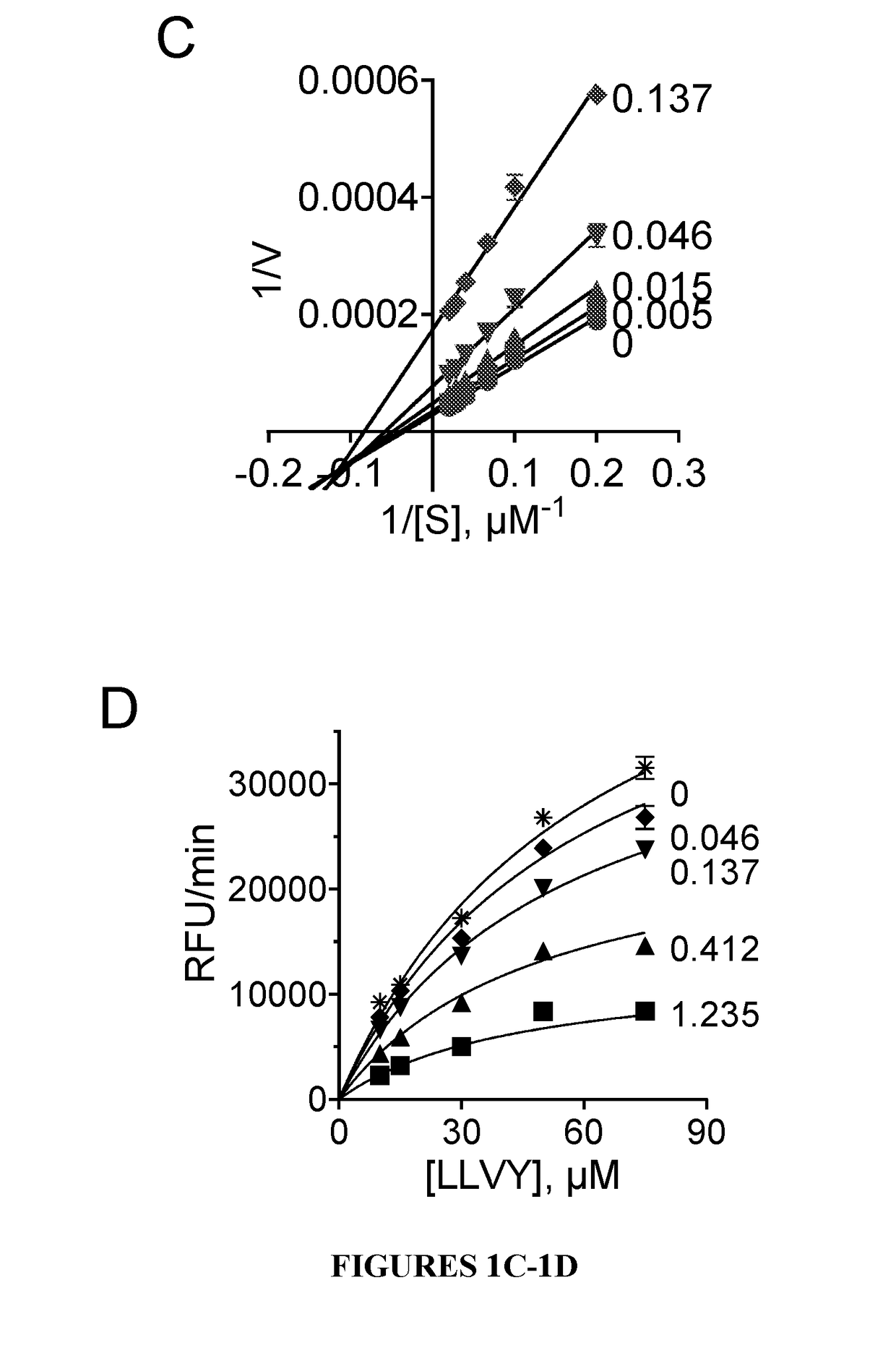Proteasome inhibitors and uses thereof
a technology of proteasome inhibitors and inhibitors, which is applied in the field of proteasome inhibitors, can solve the problems of unsuitable treatment, cytotoxic to host cells, and unsuitable for reactive warheads, and achieve the effect of high selectivity for human immunoproteasomes
- Summary
- Abstract
- Description
- Claims
- Application Information
AI Technical Summary
Benefits of technology
Problems solved by technology
Method used
Image
Examples
example 1
and Spectroscopy
[0180]Unless otherwise stated, all commercially available materials were purchased from Bachem, Aldrich, P3 BioSystems, or other vendors and were used as received. All non-aqueous reactions were performed under argon in oven-dried glassware. Routine monitoring of reactions was performed using Waters Acquity Ultra Performance Liquid Chromatography (UPLC). All HPLC purifications were done by Varian PrepStar HPLC system or Waters Autopure (mass directed purification system) using Prep C18 5 μm OBD (19×150 mm) column. 1H- and 13C-NMR spectra were acquired on a Bruker DRX-500 spectrometer. Chemical shifts 6 are expressed in parts per million, with the solvent resonance as an internal standard (chloroform-d, 1H: 7.26; 13C: 77.16 ppm; DMSO-d6, 1H: 2.50 ppm; 13C: 39.52 ppm). Hexafluorobenzene was used as internal standard for 19F NMR. NMR data are reported as following: chemical shift, multiplicity (s=singlet, d=doublet, t=triplet, q=quartet, m=multiplet, br=broad), coupling...
example 2
rocedure for HATU Mediated Amide Bond Formation
[0181]To a solution of carboxylic acid (1 equivalent), O-(7-Azabenzotriazole-1-yl)-N,N,N,N′-tetramethyluronium hexafluorophosphate (HATU, 1.2 equivalent), and 1-hydroxy-7-azabenzotriazole (HOAt; 0.6 M in DMF) in DMF, Hunig base (3-5 equiv) was added dropwise at 0° C. The mixture was stirred at 0° C. for 5 minutes and amine (1 equivalent) was added. The reaction mixture was stirred at 0° C. until complete consumption of starting material (monitored by LCMS). After completion of reaction, water was added to the reaction mixture and stirred for 30 minutes. The product was isolated by either filtration or ethyl acetate extraction.
example 3
rocedure for Boc-Deprotection
[0182]The solution of substrate in dichloromethane was cooled to 0° C. Trifluoroacetic acid (20% v / v with respect to dichloromethane) was added to the solution drop wise at 0° C. with constant stirring. The mixture was allowed to warm to room temperature slowly (over a period of 1 hour), and stirred until the completion of reaction (monitored by LCMS). Excess trifluoroacetic acid and dichloromethane were evaporated and crude was dried under vacuum.
PUM
| Property | Measurement | Unit |
|---|---|---|
| Volume | aaaaa | aaaaa |
| Molar density | aaaaa | aaaaa |
| Molar density | aaaaa | aaaaa |
Abstract
Description
Claims
Application Information
 Login to View More
Login to View More - R&D
- Intellectual Property
- Life Sciences
- Materials
- Tech Scout
- Unparalleled Data Quality
- Higher Quality Content
- 60% Fewer Hallucinations
Browse by: Latest US Patents, China's latest patents, Technical Efficacy Thesaurus, Application Domain, Technology Topic, Popular Technical Reports.
© 2025 PatSnap. All rights reserved.Legal|Privacy policy|Modern Slavery Act Transparency Statement|Sitemap|About US| Contact US: help@patsnap.com



